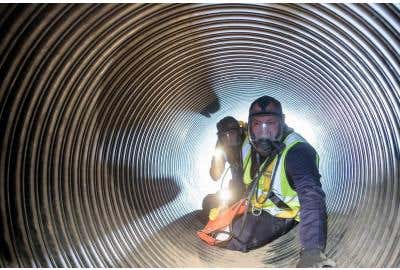Confined Spaces in Construction


No matter what sector of construction they work in, construction workers often encounter confined spaces, which can, unfortunately, involve physical hazards and environmental concerns. Over the years, there have been countless injuries and fatalities reported due to the dangerous conditions unknowingly found inside. However, with the right safety training and protocols in place, construction workers can decrease their risk for harm.
What Are Confined Spaces?
Found at almost every job site, confined spaces are not intended for workers to spend extended amounts of time in them, and they are often troublesome to exit when an emergency situation arises. The Federal Occupational Safety and Health Administration (OSHA) defines confined spaces in construction as:
- Large enough for an employee to enter
- Limited means of entry or exit
- Not designed for continuous occupancy
In addition, some confined spaces require a permit if they meet a certain set of criteria, which includes:
- Existence of a hazardous atmosphere or the potential for a hazardous atmosphere
- Threat for a material engulfing the construction worker
- Configuration inside the confined space that could trap an employee
- Potential for asphyxiation due to converging walls, downward-sloping floors or other factors
- Any other dangerous safety or health hazard, such as exposed wires and chemical leaks
Dangers of Confined Spaces
From road work to commercial and residential projects, construction workers across the country encounter confined spaces on a daily basis, such as boilers, manholes, crawl spaces, incinerators, tanks, HVAC ducts and more. Regardless of the type of confined space or construction project, numerous hazards to workers’ health and safety could exist, including exposure to toxic chemicals and gases, electrocution and even death.
One of the most common threats associated with a confined space is the effect its oxygen levels have on construction workers. Without the proper safety gear and training, sending an employee into a confined space could result in dire consequences. It only takes four minutes without oxygen for a construction worker – or any human being, for that matter – to sustain brain damage or die. Likewise, too much oxygen, known as oxygen enrichment, can cause death as well.
OSHA’s Construction Standard
To help employers identify and address the potential hazards associated with confined spaces prior to having employees work in them, OSHA put its Confined Spaces in Construction standard into place. It mandates that employers must adhere to the following regulations:
- Identification of confined spaces that require a permit
- Inspection of confined spaces by a competent person to identify hazards
- Determination of how to make hazards safe
- Education for workers on how to safely navigate confined spaces and perform rescues of victims
- Prevention of unauthorized employees and the general public into these confined spaces
Learn More with ClickSafety
Failing to adhere to OSHA’s standard for the construction industry’s confined spaces poses many unwanted outcomes to the employer. These can include lawsuits, workers’ compensation claims, fines and the reputation that comes along with employees sustaining serious injuries or even dying on your watch. ClickSafety can help your company prevent all of these consequences and enhance the safety of your employees with a number of OSHA-certified safety courses. For more information, contact us today.

